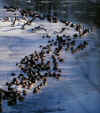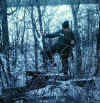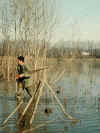| December
The annual visit of Santa Claus is the big December issue for most folks,
but for nimrods of Hoosierland--not to mention our Midwestern neighbors--the
year’s swan song offers a delectable smorgasbord of hunting and fishing
opportunity.
Sure, the prime hunting for deer has been archived before December rolls
around, but as thoughts of a big buck--or simply venison for the table--wane,
visions of hunts for numerous other species occupy the thoughts of woodsy
types, and the angling set scales down tackle for hard-water fishing.
It is, of course, the beginning of the end for all winter-oriented outdoors
types. But December, and January for that matter, offers much for those
who will quit the couch, dress for the wintry conditions they will encounter,
and get outdoors.
So what is my favorite December activity?
If you had asked me that 30 years ago--and many folks still ask--there
would have been no doubt . . . no hesitation . . . on my answer: Quail
(as in bird) hunting was my bag for many years. If you uttered the word
“quail” in Southern Indiana in those days, dyed-in-the-wool followers of
the pointing breeds of hunting dogs translated it into “bird.”
Before I-65 came into our beloved Southern Indiana I owned and hunted
two of the best bird dogs I have ever known. Duke, the dropper I grew up
with at good ol’ Crothersville, was a tad better than either Pokey or Clover,
but they were among the best dogs I ever followed. When I completed the
trio with that pair (two years apart, but from the same “Skyrocket” bloodlines)
we were averaging a covey of birds per hour until the blizzard years of
1978-79 delivered a terrible blow to bird populations.
The blizzard years almost wiped out the native Bob White in Indiana,
and the species has not recovered. Division of Fish and Wildlife biologists
blame many factors for the slow--or nonexistent--recovery of the species.
Those who still keep dogs and hunt birds not-so-quietly maintain that Mr.
Bob is not getting his due from the wildlife managers.
It is a sad state of affairs when every year fewer people have the opportunity
to enjoy this gourmet item on the table (there is no bad recipe for quail).
But the real tragedy of the situation lies in the fact that the communion
of bird dog and man is in the wake of the passenger pigeon.
The season on quail will end Dec. 19 north of State Highway 26. In the
remainder of the state the bird season will continue through Jan. 15, 2005.
(Note: For more on bird hunting find my November, 2002, column through
“Archives.”)
What is the best bet for a good hunt for Hoosier outdoorsmen in December?
My choice would be a combination duck/squirrel float on one of White
River’s two forks south of Indianapolis.
Woodland game--namely squirrel, deer and wild turkey--has fared far
better than upland species (quail, rabbit and pheasant) in the last decade
or so.
With this in mind, a floating jump-shoot for ducks would seem a good
bet. Throw in the fact that the two forks of White River are lined with
good cover of trees and bordered by harvested cornfields, and you have
ideal habitat for both waterfowl and squirrels.
The prime ingredient for this prescription to an exciting day outdoors
is high water because the ducks and squirrels certainly will be on the
two forks of the White and numerous other mid-sized streams and rivers
of the southern half of the state.
Floating hunts for ducks and squirrels on rivers and larger streams
work out best with no more than two hunters, and from a light, but river-worthy
(high sided) boat.
The boat should be camouflaged with a weed-covered screen on the bow
or stern. This will be determined by the end of the boat that goes first
when riding the current without using oars when the boat is loaded with
gear and the two hunters.
One hunter sits behind the screen with shotgun ready for action. The
other hunter crouches low in the other end of the boat (with shotgun handy)
while handling oars or paddle.
In times of high water ducks tend to feed and rest among weeds and brush
at bends of rivers or near (or in) collections of driftwood or other good
cover. The hunter handling the oars manipulates the boat close to the river
banks to get the hunter as close as possible to the ducks before they jump
and fly away Although I prefer to keep moving on a float, I carry half
a dozen dabbler decoys and use them if I think ducks jumped in an area
might return. Generally I feel that if I jump ducks while floating, they
are there because they like the spot. There is a good chance they will
return soon, especially if they are not spooked by gunfire.
Federal and state laws on waterfowl hunting allow the use of an outboard
motor in waterfowl hunting for picking up downed birds. However, it is
unlawful to shoot ducks from a boat that is under the impetus of a motor.
Steel shot also are required for waterfowl hunting, and it is unlawful
to have lead shot in possession while out for waterfowl.
Needless to say, it is a good idea to carry extra dry clothing in a
water tight container, and to wear a personal floatation device (PFD).
A Coast Guard approved vest is required for those using boats.
It also is important in strong current of a stream at flood stage to
avoid allowing the boat to float crosswise to the current. A crosswise
boat in strong current can capsize if it hits a solid object.
The seasons on ducks opened late in November in all three waterfowl
hunting zones of the state. Ducks will be fair game in the North Zone through
Dec.18, but as winter comes to that part of the state the ducks will head
south. Duck seasons will remain open in the South Zone (see waterfowl Zone
map on this website) and in the Ohio River Zone (see Waterfowl Zone mat
on this website) through Jan 21, 2005.
Here, for those not familiar with waterfowl hunting regulations are
the boundaries of the three waterfowl hunting zones:
The statewide season on squirrels opened Aug. 15. North of U.S.40 the
season will end December 31. The season south of that road will continue
through Jan. 31, 2005.
For waterfowl hunting, the North Zone is bordered on the south by State
Highway 18 east from the Illinois state line to U.S. 31; along U.S. 31
north to U.S. 24; east on U.S. 24 to the city of Huntington, and southeast
on U.S. 224 to the Ohio state line.
The northern boundary of the Ohio River Zone is I-64 east from the Illinois
state line to New Albany; east on State Highway (S.H.) 62 to S.H. 56; east
on S.H.56 to Vevay; along S.H. 156 along the Ohio River to North Landing,
north on S.H. 56 to U.S. 50, and northeast on U.S. 50 to the Ohio state
line.
The South Zone is that part of the state that lies between the southern
boundary of the North Zone, and the northern boundary of the Ohio River
Zone. This is roughly two-thirds of the state.
The North Zone season on Canada geese opened Oct. 23 and will continue
through Dec. 28. However there also is a Southern James Bay Population
(SJBP) zone for Canada geese inside the North Zone and the season on this
species ends there on Dec. 8.
The SJBP Zone includes Lagrange, Steuben, Starke, Elkhart, Jasper, and
Laporte counties and the Jasper-Pulaski State Fish and Wildlife Area.
The South Zone season on Canada geese in both South and Ohio River zones
opened late in November and will close on Jan. 31, 2005.
A statewide season on snow geese, brant, and white-fronted geese opened
late in October and will close Jan. 31, 2005.
Geese are not encountered often on floating jump shoots, but they can
be hunted with good success by learning where they feed in harvested grain
fields and luring them to decoys.
Pre-hunt scouting efforts often pay big dividends on all types of waterfowl
hunting.
(Note: For more on floating jump shoots for waterfowl go to my column
for December 1, 2003 from “Archives.”)
December also offers some good opportunity for both rabbit and pheasant
for the simple reason that colder air temperatures have killed annual weeds
and leaves are down from brush and trees.
The statewide season on pheasant will end Dec. 19, but the statewide
season on rabbit will continue through Jan. 31, 2005.
Best bet for pheasant at any time of the year is the northern tier counties--say
two counties deep across the northern border of the state. It probably
is true that our best pheasant range will be found in the northwest, but
pockets of good hunting will be found for ring-necks from one side of the
state to the other.
Harvested grain fields (especially corn stubble) adjacent to wetlands,
weed patches and brush-infested banks of drainage ditches are best producers.
Pockets of good rabbit hunting will be found throughout the state, especially
in heavy brush along abandoned railroad rights-of-way, and hillsides adjacent
to harvested cornfields.
December occasionally offers good tracking snows (fluffy dry snow is
best) for rabbit hunts, or for trips to the outdoors for tracking red fox
or mink, with or without intentions of taking the animals. A great feature
of tracking animals in the snow will be found in the fact that such weather
conditions tend to make all forms of wildlife a bit less wary. This gives
the tracker a better opportunity to observe many forms of wildlife.
I once spent an entire afternoon tracking a red fox in the flood plain
of White River. The fox crisscrossed a large field of corn stubble that
was bordered on one side by the river and the opposite side by a steep
hill covered with broom sedge and other dead annual grasses and weeds.
As darkness approached, the tracks led me to a high point on the hill.
I had to smile at being outsmarted when I found evidence in the snow that
Old Reynard had been sitting on his haunches in the middle of s clump of
sedge watching every move I made as I followed his tracks for some two
hours. The snow told me that as I had approached his vantage point, he/she
had slinked east through the weeds and crossed a road into a large thicket
where I gave up the chase without seeing my quarry. My reward for the winter
afternoon, had been finding evidence that the fox had lunched the night
before on a cardinal and a field mouse--small spots of blood and feathers
and hair telling their story.
Although angling normally is considered an outdoor activity of
spring and summer, for the army of hard-water anglers spudding in holes
for fishing on a raw winter day is as exciting as sorting a euchre hand
to find right bower, left bower, and the other top trumps.
In an ordinary winter ice fishing gets its start in the northern-tier
of Hoosierland about the time Santa is loading his sleigh for his annual
sally for billions of kids of all ages. This land of natural lakes of the
northern tier of counties--not to mention numerous man-made bodies of water--serves
as a pretty good prognosticator of things to come as winter conditions
bluster their way southward toward the Ohio River.
In an exceptionally warm winter, central and southern lakes and
smaller bodies of standing water may have little ice that is safe enough
for fishing. Still, smaller standing waters of central--and maybe southern--parts
of the state will offer some hard-water fishing.
The important thing to remember about ice fishing--no matter where you
try your luck--is that ice is treacherously dangerous stuff. Even when
Ice appears thick and safe it is good to prepare in advance to get out
if you should get wet.
It is best to fish with other anglers and to have a plan for getting
a member of the party out, in the event of a dunking. But solo anglers
can have their own plans for getting out, and the best method I have devised
is a lengthy piece of clothesline (or strong rope), and a two-foot length
of broomstick or a sturdy tree limb.
It is best to have the clothesline (rope) attached to a solid object
(like a tree) on the bank. The other end of the line is tied loosely around
the angler’s waist. However, if the rope is not long enough to reach the
bank, one end can be secured to the middle of the broomstick. Spud in a
hole a safe distance from the fishing site and place the broomstick crosswise
in the hole. With the rope tied around the waist, an angler will have something
to pull against if needed.
Click on thumbnail
photo to see enlarged image.
 |
 |
 |
| Clover's points told me there would soon be
action. |
Ducks and geese often congregate on ice at the
edge of open water on rivers and other waters. |
Mallards and other dabbling ducks often rest
through the middle of a winter day on rivers and streams. |
 |
 |
 |
| The thick cover adjacent to abandoned railroad
rights-of-way offer great rabbit habitat . . . hunting to equal it. |
The screen on boat should be just heavy enough
to break the lines of the boat and the hunters. |
Decoys will help bring ducks back to favorite
resting, feeding spots. . . this hunter positions decoys on an inundated
White River island. |
|

